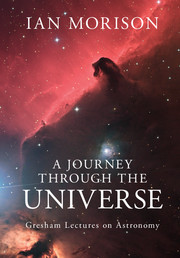Book contents
- Frontmatter
- Dedication
- Contents
- Preface
- Acknowledgements
- 1 Watchers of the skies
- 2 Our Sun
- 3 Aspects of our Solar System
- 4 The rocky planets
- 5 The hunt for Planet X
- 6 Voyages to the outer planets
- 7 Harbingers of doom
- 8 Impact!
- 9 Four hundred years of the telescope
- 10 The family of stars
- 11 Aging stars
- 12 The search for other worlds
- 13 Are we alone? The search for life beyond the Earth
- 14 Our island Universe
- 15 Wonders of the southern sky
- 16 Proving Einstein right
- 17 Black holes: no need to be afraid
- 18 It’s about time
- 19 Hubble’s heritage: the astronomer and the telescope that honours his name
- 20 The violent Universe
- 21 The invisible Universe: dark matter and dark energy
- 22 The afterglow of creation
- 23 To infinity and beyond: a view of the cosmos
- Index
- Plate section
- References
22 - The afterglow of creation
Published online by Cambridge University Press: 05 October 2014
- Frontmatter
- Dedication
- Contents
- Preface
- Acknowledgements
- 1 Watchers of the skies
- 2 Our Sun
- 3 Aspects of our Solar System
- 4 The rocky planets
- 5 The hunt for Planet X
- 6 Voyages to the outer planets
- 7 Harbingers of doom
- 8 Impact!
- 9 Four hundred years of the telescope
- 10 The family of stars
- 11 Aging stars
- 12 The search for other worlds
- 13 Are we alone? The search for life beyond the Earth
- 14 Our island Universe
- 15 Wonders of the southern sky
- 16 Proving Einstein right
- 17 Black holes: no need to be afraid
- 18 It’s about time
- 19 Hubble’s heritage: the astronomer and the telescope that honours his name
- 20 The violent Universe
- 21 The invisible Universe: dark matter and dark energy
- 22 The afterglow of creation
- 23 To infinity and beyond: a view of the cosmos
- Index
- Plate section
- References
Summary
Predictions of a ‘hot’ Big Bang and hence the presence of radiation within the Universe
Two American scientists, George Gamow and Richard Dicke, independently predicted that very high temperatures must have existed at the time of the Big Bang – both for somewhat the wrong reasons. Gamow wanted the temperature to be very high so that all the elements found in nature could be synthesised in the early stages of the Universe. We now know that apart from nitrogen (in the CNO process) the elements are created during the later stages in the life of stars and, in the case of massive stars, during the end of their life in a supernova explosion.
The other prediction was made by Richard Dicke, a physicist at Princeton University. He, like Fred Hoyle, did not like the idea of a singular start to the Universe (what was there before?) and came up with the idea of an oscillating universe in which the Universe expands up to a maximum size and then collapses again to a singularity (called the Big Crunch) of the maximum density possible before expanding again. Since Gamow’s failure to explain the formation of the elements heavier than helium, Hoyle and others had shown how the heavier elements had been formed in stars. Thus, to start afresh with a new expanding universe, all the heavier elements had to be destroyed. Dicke realised that extreme heat – temperatures of at least a billion degrees – would do the job nicely as the heavy elements would crash together and split up into their constituent protons, neutrons and electrons.
- Type
- Chapter
- Information
- A Journey through the UniverseGresham Lectures on Astronomy, pp. 320 - 335Publisher: Cambridge University PressPrint publication year: 2014



